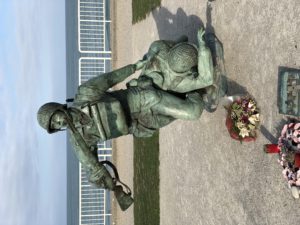
Before leaving France we felt that we should go to Mont St. Michel and the historic beaches of Normandy. The town of Bayeux is a charming French village – and a great landing place to tour both sites – so we booked an Airbnb and made our way north.
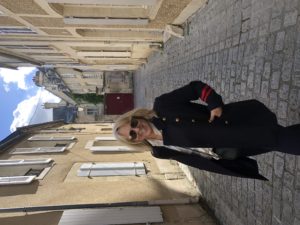
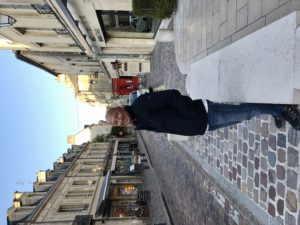
Bayeux is a small, picturesque town with cobblestone streets and beautiful old stone buildings. When first rolling to our Airbnb, (literally rolling our luggage twenty minutes through town since there were no taxis at the train station) we were struck by the incredible grandeur and immensity of Bayeux’s cathedral.
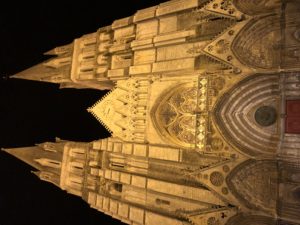
It turns out that Bayeux is a very old town with a long complex history. It was first established in the 1st century by the Romans and by the 3rd became a walled-in city. Most of the city’s original layout remains today. The town has many cute restaurants and boutiques.
The cathedral named Cathedral of Our Lady of Bayeux was consecrated by William the Conquerer, King of England, in 1066. It originally housed a 70 meter long tapestry that depicts how William, the bastard son of the King Edward, led a crusade to overthrow King Harold who stole the crown from him after King Edward’s death – very Game of Thrones-ish. The tapestry is really incredible and remains in great condition considering its age. It is now housed in a special semi-circle museum where you can view it with a great audio accompaniment. A must see if in Bayeux.
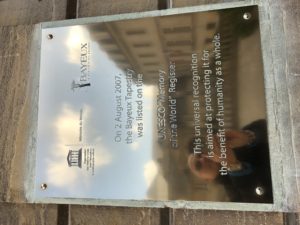
The tour of Normandy beaches is where the American, Canadian and British armies invaded and ultimately defeated the occupying Nazis, famously known as D-day. Touring this area is very interesting but depressing and profoundly moving. We toured Omaha Beach and the American soldier cemetery. When you hear the story of how most of the invading soldiers were suffering from food poison, sea sickness, blinding visibility, horrible strong currents and capsizing waves, it really is amazing that they were successful. Standing at the shore, looking at the ominous German machine gun bunkers on the cliffs, it felt terrible thinking about what the first and second wave of troops experienced. Only a small percentage of these very young – mostly 18 to 23 years old – American soldiers made it onto the beach. In fact, it was a horrible blood bath as the Germans gunned down thousands. In addition, virtually all of the amphibious tanks failed to make it to shore through the swirling seas with six foot waves. Over the next month, the invading American, British and Canadian troops cornered 21,000 young German soldiers in a small inland area, which is known as the German mass grave. War is so hard, with true heroes, and very, very sad.
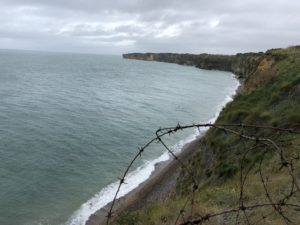
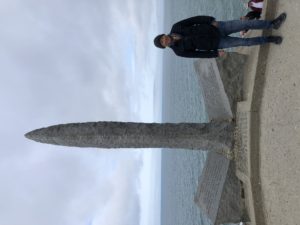
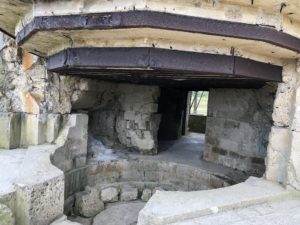

The next day we visited Mont Saint-Michele – the second most visited site in all of France. The first glimpse of this huge granite island with its abbey built rising towards god, is absolutely stunning. It’s situated in a huge bay surrounded by water at high tide and sand at low tide. The sand looks easy to cross but we learned that it can be very dangerous as it’s ridden with quicksand. People can walk to the Mont St. Michele through the sand but it’s apparently important to have a knowledgeable guide.
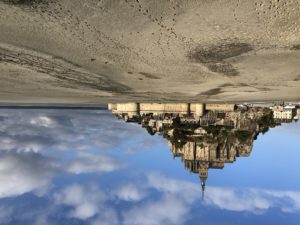
Our tour took us across the long bridge that ends just before the opening arches of the island. Legend has it that the archangel Michael appeared in three dreams of the bishop of Avranches in 708 instructing him to build a church on the rocky islet. The church took 60 years to build and was ultimately finished in 1103 with archangel St. Michael towering on the top in gold. This large monastery has many rooms, crypts and chapels under the main abbey that are fortified with large supports and thick walls. Even with all these architectural fortifications the North wall collapsed right after the abbey was constructed. Mont Saint-Michel has gone through a long history of fires, collapses and changes. It is a UNESCO world heritage site and well worth the visit.
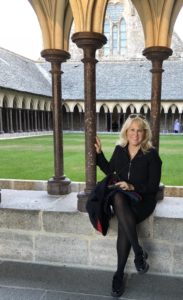
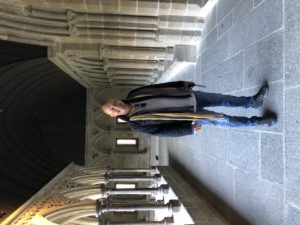
After our two-day tour of Bayeux and Mont St. Michel, we are headed back to Paris for a quick stopover on our way to Scotland!